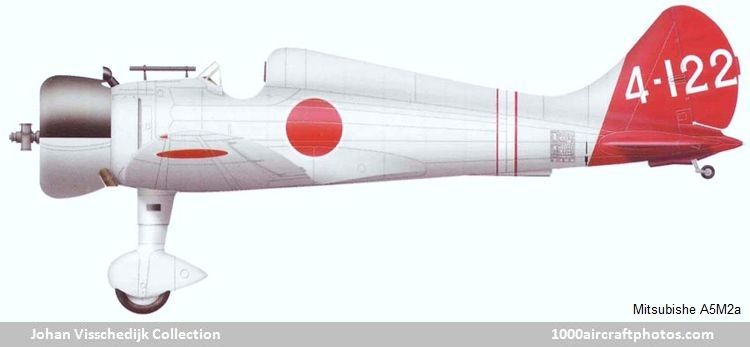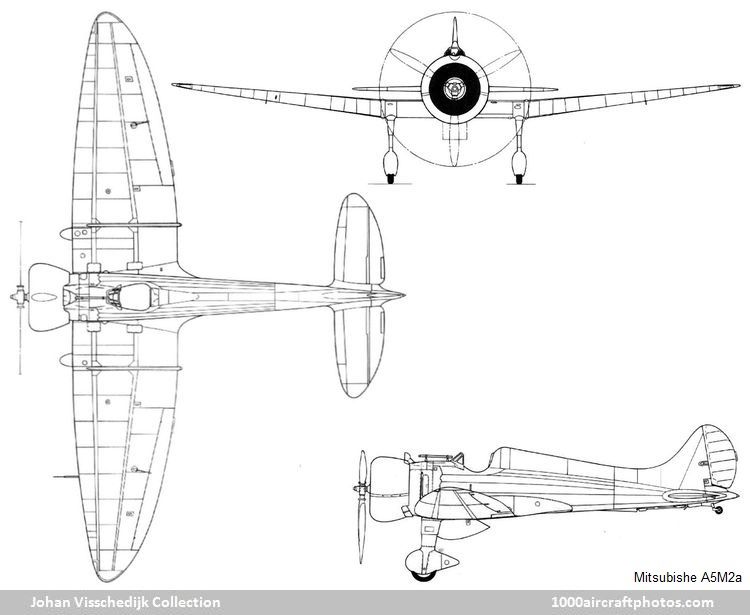12/31/2023. Remarks by Johan Visschedijk: "Evolved to a 9-Shi (1934) requirement for a Single-seat Shipboard Fighter, the Mitsubishi Type 96 Carrier Fighter, or A5M, was the first fighter monoplane to be accepted by the IJN and was still standard carrier equipment when the Pacific War began, not being fully replaced as a first-line aircraft until the summer of 1942. The IJN 9-Shi specification called for a maximum speed in excess of 218 mph (350 kmh) at 10,000 ft (3,048 m), the ability to attain an altitude of 16,400 ft (5,000 m) in less than 6.5 minutes, and an armament of two 0.303 in (7.7 mm) machine guns. The Nakajima Kotobuki (Congratulation) 5 air-cooled radial engine rated at 550 hp was selected for installation in the first prototype which was flown for the first time on February 4, 1935, only eleven months after the inception of the design.
During trials, the new fighter, which bore the manufacturer's designation Ka-14, attained 280 mph (450 kmh) at 10,500 ft (3,200 m), and climbed to 16,400 ft (5,000 m) in 5 min. 54 sec. After the completion of the initial flight test phase, it was decided that, owing to pitching oscillation and a tendency to balloon when landing, the first prototype would be used for structural tests, and the flight program continued with the second prototype.
This differed from its predecessor in having a straight wing in place of the original inverted gull wing, and was also fitted with split flaps and a 560 hp direct-drive Kotobuki 3, the reduction gears of the Kotobuki 5 being considered inadequately developed for service use. A similar prototype was evaluated by the IJAAF as the Ki-18 in the autumn and winter of 1935.
Further prototypes were built with the Nakajima Hikari (Splendour) 1 engine rated at 700 hp, but when the IJN accepted the aircraft for service as the A5Ml Type 96 Carrier Fighter, Model 1 in 1936, the 585 hp Kotobuki 2-KAI-1 was chosen, armament comprising two 0.303 in (7.7 mm) Type 89 machine guns.
In 1937, the A5M2a Model 21 with the 610 hp Kotobuki 2-KAI-3 was placed in production, this becoming the most important IJN fighter in the Sino-Japanese conflict. The A5M2b Model 22 had the Kotobuki 3 engine of similar power and an enclosed cockpit, but when this variant entered service in the late summer of 1937, pilots complained that performance was inferior to that of the earlier version, and they distrusted the enclosed cockpit. Therefore the A5M2b was withdrawn from service, and the enclosed cockpit was discarded on subsequent production models. The A5M3 Model 23 was an experimental model with a 610 hp Hispano-Suiza 12Xcrs engine and a 0.787 in (20 mm) Oerlikon FF cannon firing through the airscrew hub, and the next production model was the A5M4 Model 24.
The A5M4 which entered production in 1938 had a 710 hp Kotobuki 41 engine driving a three-blade airscrew, and this model was the standard IJN fighter when the Pacific War began. The A5M4 Model 34 had a Kotobuki 3-KAI engine, and the A5M4-K Model 44 was a two-seat training variant. A total of 1,094 aircraft were manufactured by Mitsubishi (nine prototypes and 782 A5M1 to A5M4s), Watanabe Tekkosho (39 A5Ms), and Dai-Nijuichi (161 A5M4, 103 A5M4-Ks). By the summer of 1942, the A5M4 had been entirely relegated to second-line and training units. The allied code name "Claude" was allotted to all A5M versions."


